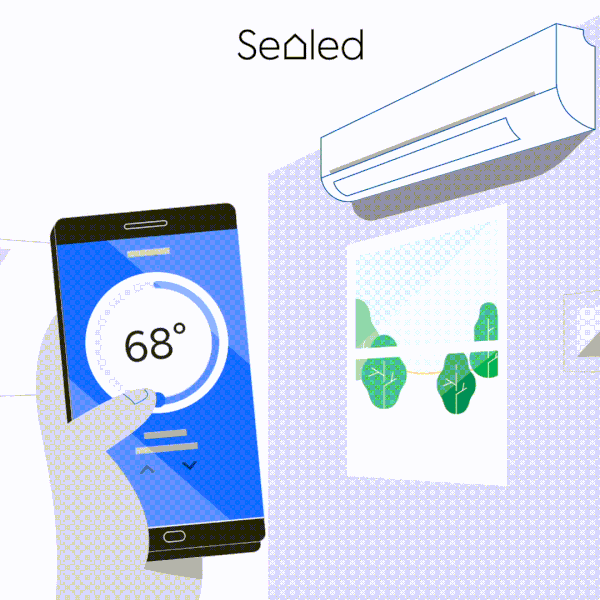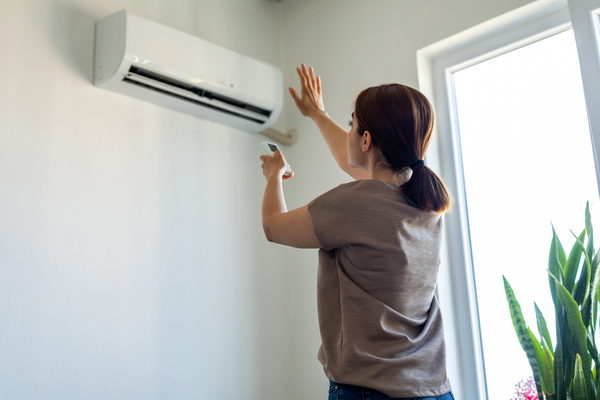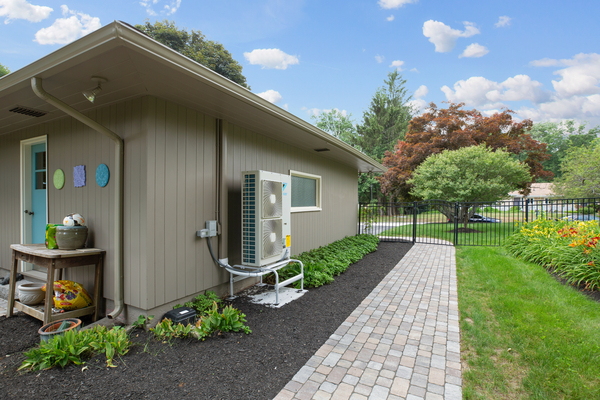Adding AC to an old house? Avoid these common mistakes and discover the best kind of AC for old houses.
If you grit your teeth every time someone tells you, “Oh, man, I’d just love to live in an old home like yours”—we hear you.
Old homes are beautiful, but they come with a big maintenance commitment and a set of significant HVAC challenges. Not least: Keeping every room cool and comfortable in summer. (Heating old homes can be tricky as well.)
Don’t get us wrong—AC can be a challenge in newer homes, too, but old houses have a reputation for being impossible to keep comfortable during hot summer months. (We know. At Sealed, we’ve upgraded a lot of old houses.)
But here’s the thing: With the AC technology that’s available now, you don’t have to suffer in your old house. AC systems that are efficient, don’t require invasive ductwork, and—most importantly—keep every corner of your old house cool really do exist! (Tap here to see if you can get one from Sealed for zero money upfront.)
In this article, you’ll learn what you need to know when adding AC to an old house. We’ll discuss the challenges and benefits of putting central air in an old house, the mistakes you should definitely avoid, and the best kind of AC for old houses.
Let’s get into it.
With the AC technology that’s available now, you don’t have to suffer in your old house.
Table of contents:
- Installing AC in an old house: The primary challenges
- Adding AC: Here’s how to do it
- What about window AC units?
- Can you install central air in an old house?
- Can you put central air in a house with no ductwork?
- How much does it cost to install central air in a house that doesn’t have it?
- How to make your old house feel amazing—for $0 upfront
Key points:
- Installing central AC in an old house can present a unique set of challenges, but some options don’t require invasive installation if you have poor ductwork (or none at all). Mini splits are the energy-efficient choice for even, comfy cooling all summer and cozy heating all winter.
- If you have uneven temperatures, drafty rooms, and stuffy spaces in your older home, insulation and air sealing upgrades need to happen alongside your AC installation. If not, you’re just wasting energy to cool your home with a new appliance and decreasing your HVAC lifespan.
- Older homes—and especially historic ones—require care and expertise with HVAC upgrades. But home energy rebates and tax credits can help ease the project costs. At Sealed, we’re home performance experts and can help you understand what rebates your improvements are eligible for. See if you qualify to work with Sealed.
The main challenges of installing AC in an old house
A few key factors make old houses particularly cranky when it comes to getting good AC performance:
- Lots of air leaks
- Uneven or absent insulation
- Unique design
- Old or missing ductwork (or none at all)
- Beautiful architectural features
1. Lots of air leaks
Old houses tend to have a lot of gaps and cracks around windows, doors, and other openings—called air leaks—which means lots of air exchange with the outside.
Outside air is a genius at getting in all those gaps. If your house hasn’t been professionally air sealed, it can be very tricky (read: impossible) to maintain a consistent indoor temperature.
2. Uneven or absent insulation
Insulation has come a long way in the last century—but it’s very possible your house has been left behind. Many older and historic houses have insufficient insulation (or are not insulated at all!), especially in non-living areas like the attic.
Having a house that’s under-insulated often results in a vicious cycle in which hot summer air is actively sucked into your home. (This is called the Stack Effect, and you can learn more about it here.) Result: Major hot spots throughout the house.
Insulation has come a long way in the last century—but it’s very possible your house has been left behind.
At Sealed, we’re experts at customizing a plan to make every home energy efficient and comfortable, no matter how old it is. Here’s what Lawrence had to say about his Sealed experience:
“Recently our 1790 colonial was insulated by Sealed. They did a thorough job in evaluating our home and then coming up with a plan. […] Our thermostat is set at 68° when we get home, and then around 7 PM I turned it down to about 60° and by 11 PM our house is still holding temperature at 66°. We are completely satisfied with the work done…. The only thing I’m sorry about is that I didn’t know about Sealed 20 years ago. I would recommend this company to anybody, and insulating your home is a no-brainer.” Lawrence G., Sealed customer
3. Historic design
Your old house’s unique layout might also be the thing which makes it difficult to cool.
High ceilings, large windows, old basements and crawl spaces, and oddly shaped rooms can all contribute to uneven temperatures—especially if you only have one thermostat for the entire house.
4. Old or missing ductwork
Old or missing ductwork: If your house has ductwork, there’s a good chance that it’s either outdated or in poor repair, which makes it pretty difficult to control the temperature.
(And plenty of historical homes don’t have ductwork at all—they just weren’t designed with modern air conditioning in mind!)
5. Beautiful architectural features
This is admittedly a bit of a cheat, because it doesn’t directly affect your AC.
But if your home is full of one-of-a-kind features and historically valuable elements, you’re probably reluctant to undertake any invasive installation project that might affect (or destroy) some of your home’s best qualities.
Okay, that’s a significant list of challenges. But if you’ve read this far, we’re guessing it means that you haven’t given up on solving them.
And that’s good. Because it is very possible to solve all these challenges. Here’s how to install AC that won’t harm your old house and is more than up to the task of keeping you cool. (At least temperature-wise. Air conditioning won’t do anything about your dad jeans.)
(Related read: Here’s when to replace your air conditioner)
Adding AC in an old house? Here’s how to do it.
Okay, here’s your cheat sheet for putting AC in an old house. It really just comes down to two major steps.
Step 1: Stop air exchange with the outside
Before we jump into the nitty-gritty of the AC installation process itself, we’ve got to tackle the air exchange issue. Because no matter what AC system you choose, it won’t be effective if the cool, conditioned air keeps escaping the house.
What does that mean for you?
Basically, it means you need to call in the pros to air seal and insulate your home. Air sealing means closing up all the little gaps and cracks that let cool air escape, and upgrading your insulation generally includes adding better insulation in the attic and foundation of your home.
(Important: If your house qualifies, you can get all of this work done by experts for no upfront cost—eligible local rebates included.)
No matter what AC system you choose, it won’t be effective if the cool, conditioned air keeps escaping the house.
Why do you need to do both? Well, air sealing and insulation are two sides of the same coin—they work in tandem.
- Insulation makes sure that energy isn’t being wasted through your house’s larger areas, like the walls, attics, and crawl spaces.
- And air sealing the gaps and cracks around windows, doors, and other openings prevents air from escaping through all the tiny openings (and older homes have plenty, believe us).
Both upgrades are equally important if you want a comfortable home, especially in an older house, where it’s crucial to cover all the air exchange basics. Old houses have so many nooks and crannies and weird places where air can escape. If you only address air exchange halfway, you’re not going to get the results you need.
A quick word before we go on: We know it’s tempting to just hop right to the next section, but please don’t make the mistake of assuming you can ignore any air exchange issues.
Old houses are notorious for wasting energy, and if you replace your AC without addressing that problem… well, it’s pretty likely that you won’t get the results you need. Plus, your AC is going to be overworked its entire life, which will reduce its lifespan and your comfort.
Step 2: Pick an AC system that can handle the foibles of older homes
When it comes to the question of, “What’s the best AC for old houses?” there’s a pretty clear answer:
An energy-efficient heat pump is far and away the best AC system if you’re installing air conditioning in an old house.
If you’ve never heard of a heat pump before, you’re not alone.
Basically, a heat pump is an all-in-one HVAC solution that heats, cools, dehumidifies, and filters the air inside your home—no need for a separate furnace or anything.
It’s up to 3x more efficient than traditional HVAC, and it’s basically perfect technology for older houses—especially if you go with a mini-split heat pump system (1).
A heat pump heats, cools, dehumidifies, and filters the air inside your home—no need for a separate furnace or anything. And it’s up to 3x more efficient than traditional HVAC.
(Learn more about what heat pumps are and how they work.)
Here’s why mini-split heat pumps are the best option when it comes to AC for older houses :
1. Zone-by-zone temperature control:
We’ve already discussed that old architecture can be tricky to cool evenly, but mini-split heat pumps solve that problem by allowing you to control the temperature in each room individually. That means every important area of your house can be exactly the temperature you want it to be.

(Read how to cool the upstairs of a 2-story home.)
2. No ductwork required:
Unlike traditional central air systems, mini-split heat pumps do not require ductwork. This is a big advantage for older homes. Installing ductwork can be both expensive and invasive, causing irreparable damage to your house’s historic integrity.
3. Super-efficient and easy maintenance:
We already mentioned that heat pumps are up to 3x more efficient, so we’ll just note here again: You’ll see the difference in your energy usage. But heat pumps are also easy to maintain—usually only requiring routine cleaning and filter replacement. And since one heat pump system will replace your furnace, air conditioner, dehumidifier, and air filter—you’ll find yourself with a lot less HVAC maintenance overall. (Which means you’ll have lots more energy for the other 517 things your old house needs!)
4. Solves heating and cooling problems with one system:
Year-round comfort in one system. It’s nice. (Really nice. Much nicer than installing central air and heat in an older home.) And a heat pump can keep your house warm in winter without drying it out like a gas furnace.
5. The least stressful way to air condition an older home:
Older houses are a challenge. Heat pumps are not. It’s great to not have to worry about your HVAC anymore. Heat pumps are “set it and forget it” HVAC systems. No need to turn them up during the day, down at night, or continually mess with their settings to save energy.
Older houses are a challenge. Heat pumps are not.
Is there a downside to mini-split systems? Well, kind of.

Some heat pump models are a bit more visible than ducted HVAC systems, because you’ll need to install some mini-split units on the walls throughout your home. So you’ll need to decide on a camouflage strategy to ensure those units blend in seamlessly with the rest of your house.
(This isn’t a big deal and can even be fun! Get tips on decorating around mini splits here.)
What about window AC units?
An important aside here while we’re talking about air conditioning: It’s easy to fall into the trap of thinking you can fix uneven temperatures by just buying a bunch of window AC units. Don’t do this.
Window units work decently as temporary solutions, but they’re awful as a permanent fix. You might save a little money upfront, but you’ll get less control over temperature, have a lot more maintenance and draining to perform, and you likely won’t save any money in the long run.
(Window units waste a lot of energy, especially compared with heat pumps.)
And a word of caution: Mini-split heat pumps are amazing, but they’re not a DIY project—especially in an older house, where any installation mistakes can be expensive and unsightly. Call in the experts (we’re only a call away). Talk to us.
Alright, we’re almost done, but there’s one more air conditioning topic to cover here. The mini-split heat pump is usually the best option, but what about central air for an older home?
Are there any situations when installing or upgrading a traditional, central air system is a good idea?
The answer is… Maybe.
Can you install central air into an old house?
The short answer to this question is: Yes, you can absolutely install central air into an old house.
But let’s talk briefly about this: What if you live in a house that already has ductwork and you just want to upgrade your central air system? Or what if you’re considering installing new ductwork so that you can install a central air system?
First, let’s resolve an important question:
Can you put central air in a house with no ductwork?
No. If you want a central air system, you’ll need to install ductwork first. And that can hit the wallet hard. (That’s why we highly recommend a mini-split AC system in this case. New ductwork can be expensive!)
How much does it cost to install central air in a house that doesn’t have it?
For ductwork, you’ll need to pay between $15-40 a foot (2)—which can add up to a bill of thousands of dollars, especially in older houses where the layout and installation process can be intricate.
And the cost to install ductwork in an older home is in addition to the price of your new AC system (generally between $4-8k—not including labor (3) and also before you add in the cost of a new heating system for an older house (which you’ll certainly want if you’re installing new ductwork).
By the time you tally all of those costs, you’ll likely wish you’d skipped the central air idea and just gotten a mini-split system.
There’s one thing that’s important to think about before you decide to add new ductwork to your old house: What effect is the installation itself going to have on your house?
Thing is, when you add ductwork to older homes, you’ll likely need to cut into the walls, ceilings and floors. And that means some unintended consequences, like damage to the very things that give your home its unique charm.
Basically, if you want to avoid an invasive and costly installation, skip the ductwork. But what if you already have ductwork and you just want to upgrade your HVAC system?
In that case, here’s an option we’d recommend: Opt for a standard-split heat pump system. With this kind of system, you’ll still get most of the efficiency benefits of a heat pump—but your conditioned air will be delivered through your existing ductwork. (But, unfortunately, you won’t get the same kind of zone-by-zone cooling that you would with a mini-split system.)

Note that we’d only recommend this option if both of these conditions are met:
- The ductwork in your house is in great condition
- An expert has told you that it will work for your home
If your house has old or insufficient ductwork or if the layout just doesn’t work for efficient central cooling, you’ll likely be better off with mini splits.
Whatever kind of heat-pump AC you choose, though, you might be relieved to know that you may be able to get a new heat-pump HVAC system—and all the insulation and air sealing upgrades you need to support it—for no upfront cost.
Interested? Read on.
How to make your old house feel amazing—for $0 upfront
At Sealed, we know old houses. And we know how to make yours feel amazing.
If your old house qualifies for a Sealed energy makeover, you’ll get a free expert energy assessment of your home—and we’ll create a customized plan for your energy upgrades.
You’ll learn exactly what you need for a more efficient, comfortable home (such as whole-home air sealing, duct sealing, or attic insulation—whatever’s necessary for your situation!).
By the way, every plan is completely custom and we never push anything you don’t need. If a new energy-efficient heat pump is right for you? You got it. If you don’t need a new HVAC system, skip it for now.
After you approve the upgrade plan, we’ll hire and vet the best local contractors and manage the entire project from start to finish—all with an energy-savings guarantee.
The whole process was easy and quick; and throughout the process I felt at ease…. I was truly impressed with the program and the level of service I received from Sealed.
Cynthia B., Sealed customer
Then—after we make your old house completely comfortable—you’ll pay for the work done with one of the flexible payment options that’s best for you.
Want to see if you qualify? Get started now—our questionnaire only takes a few minutes to complete.